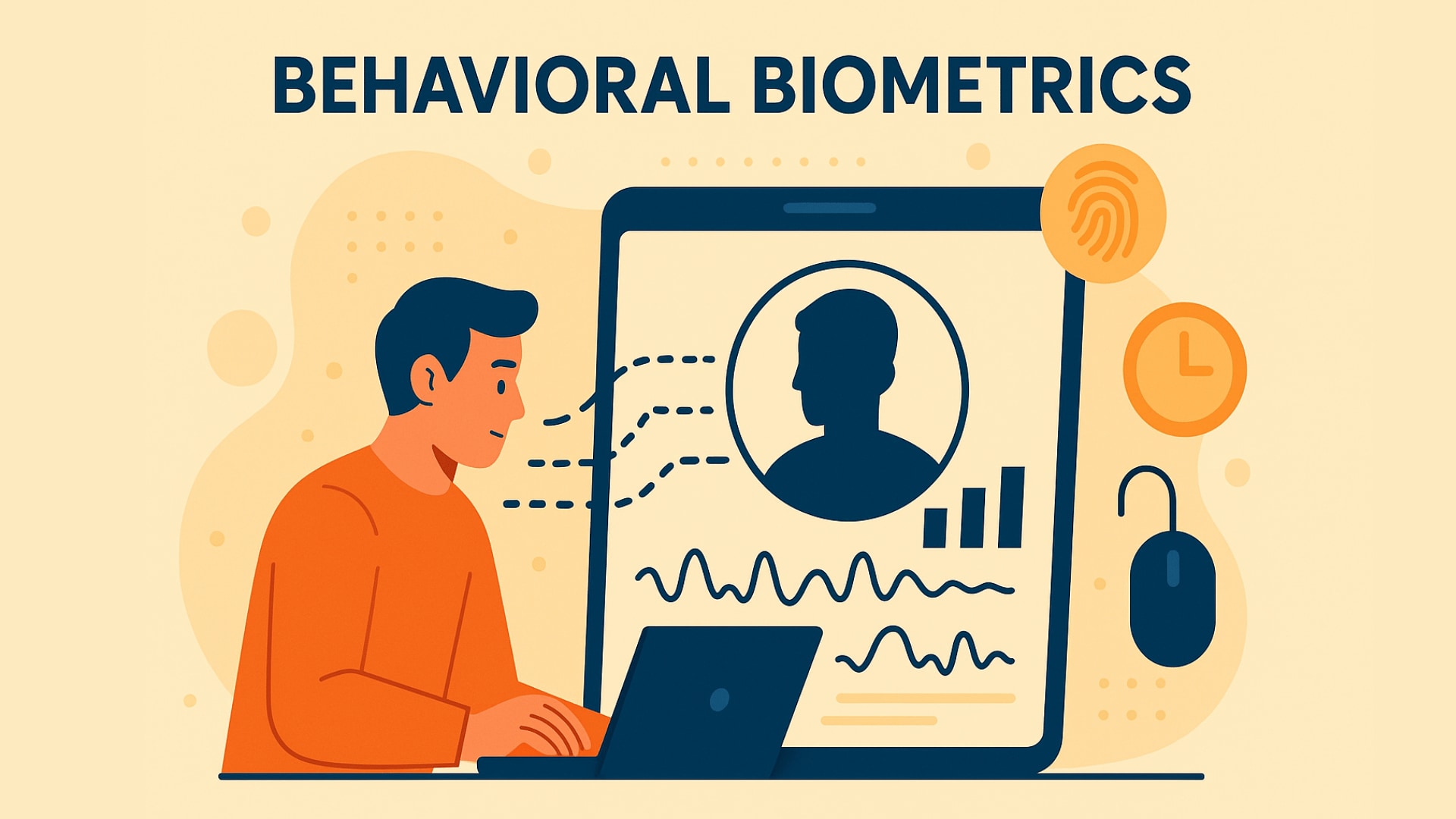
Cybersecurity for businesses is one of the biggest challenges today. New threats emerge every day, and traditional security measures are quickly becoming inadequate. To defend against these threats, innovative technologies are needed. One particularly promising method in the field of web security solutions is behavioral biometrics authentication.
Table of contents
What is Behavioral Biometrics?
You may already be familiar with traditional biometric methods, such as fingerprint scanners or facial recognition on your smartphone. While you may have concerns about the privacy and security of these technologies, behavioral biometrics offers a modern alternative that addresses these issues while leveraging the strengths of traditional biometrics.
At its core, behavioral biometrics authentication analyzes unique behavior patterns that emerge during user interactions with websites or mobile apps. These patterns—such as typing speed, mouse movement, or touchscreen usage—are difficult to mimic or forge and cannot be used to identify a person. Instead, they are used solely for authentication purposes.
How Does Behavioral Biometrics Work?
Behavioral biometrics authentication relies on advanced technologies like artificial intelligence (AI) and machine learning to convert human behavior into unique biometric data. As users interact with a website or mobile app, the system continuously analyzes thousands of parameters in the background. These parameters are not limited to typing speed or rhythm on a keyboard but also include subtle details like how a user moves their mouse, the speed and direction of their touch gestures on a screen, or how they hold their device. All of these small yet significant aspects of behavior contribute to a unique digital signature for each user.
This system works by creating a detailed profile of a user’s behavioral patterns. Even if attackers overcome traditional security methods, such as passwords or PINs, the system can still detect unusual behavior patterns that are indicative of a bot or fraudulent activity. For example, bots often input data in a uniform and automated way, whereas human interactions tend to be more irregular and varied. By continuously monitoring and analyzing behavior, the system can flag discrepancies in real-time, identifying potential threats before they escalate.
Benefits of Behavioral Biometrics Authentication
Behavioral biometrics authentication offers several distinct advantages when it comes to improving cybersecurity for businesses. One of the key benefits is its ability to continuously monitor user activity throughout their session, not just during login. This ongoing authentication provides an added layer of protection. That helps detect bot attacks, account takeovers, and other fraudulent behaviors in real-time. Unlike traditional security methods that only check a user’s identity once, behavioral biometrics ensures that the user is continuously verified. This is making it much harder for malicious actors to go undetected.
Additionally, the process is seamless for users. Because behavioral biometrics works passively in the background, it eliminates the need for users to remember complicated passwords or go through lengthy authentication processes. This enhances the user experience, increasing overall satisfaction and reducing friction. Businesses can thus enjoy higher user engagement while maintaining strong security measures.
Another benefit is the system’s ability to adapt to varying levels of risk. For instance, if a user performs an unusual action—like initiating a large transaction — the system can dynamically trigger additional security measures, ensuring that every aspect of the interaction is secure. This flexibility helps balance strong protection with ease of use, without overwhelming legitimate users with unnecessary verification steps.
Real-world Use Cases
Many industries have already begun adopting behavioral biometrics for improved cybersecurity. Here are a few examples:
- Online Banking: A leading online banking provider successfully implemented behavioral biometrics to detect fraudulent transactions and improve security. After integrating the technology, the company reported a 40% reduction in fraudulent login attempts.
- E-Commerce: E-commerce businesses are increasingly using behavioral biometrics to protect customers during the checkout process, preventing fraud while offering a smooth and secure shopping experience.
- Healthcare: Healthcare providers are using behavioral biometrics to safeguard patient information and prevent unauthorized access to medical records, ensuring compliance with privacy regulations.
These examples highlight the versatility of behavioral biometrics in diverse sectors and its ability to improve security without compromising user experience.
Future of Behavioral Biometrics in Cybersecurity
As artificial intelligence (AI) and machine learning technologies continue to evolve, behavioral biometrics will become even more effective and accurate. Future advancements may enable the recognition of even subtler behavioral patterns. This would improve the detection of new, more sophisticated threats like AI-driven attacks and advanced botnets.
Behavioral biometrics will also become more adaptable to various digital platforms, ensuring its relevance in a world where cybersecurity needs are constantly shifting. As businesses embrace digital transformation, this technology will play an integral role in safeguarding online transactions and interactions.
Privacy in Behavioral Biometrics
Behavioral biometrics authentication raises important questions about privacy. However, this technology respects user privacy by analyzing behavior patterns without storing personal identifying data. Behavioral biometrics differs from traditional biometrics, which rely on physical traits like fingerprints or facial recognition. It does not track or store sensitive personal data. This ensures compliance with privacy regulations, including GDPR.
captcha.eu follows strict privacy policies and complies with GDPR to ensure that your users’ privacy is protected while providing effective bot protection.
Challenges and How to Overcome Them
Implementing behavioral biometrics authentication is not without its challenges. One common hurdle businesses face is the integration of this new technology with their existing security infrastructure. Many companies rely on legacy systems, and incorporating behavioral biometrics requires careful planning and technical expertise to ensure compatibility. The solution lies in working with a provider that offers comprehensive support and seamless integration, minimizing disruptions during the implementation process.
Another challenge is user resistance, especially with new authentication methods. Some users may feel uneasy about continuous monitoring, even if their personal identity isn’t tracked. To address this, clear communication is key. Businesses should educate users on how behavioral biometrics enhances security while respecting privacy. It’s important to emphasize that the technology is designed to protect users, not intrude on their personal data.
There may be concerns about false positives and ensuring the system correctly identifies legitimate users. However, behavioral biometrics uses advanced machine learning to improve accuracy over time. By learning from user interactions, the system refines its ability to distinguish between normal behavior and potential threats. This reduces false positives and ensures a smoother user experience.
Captcha Solutions and Behavioral Biometrics
While behavioral biometrics offers powerful protection against advanced threats, CAPTCHA solutions still play an essential role in blocking basic bots. A multi-layered security approach, combining CAPTCHA with behavioral biometrics, provides comprehensive protection and ensures both user convenience and security.
captcha.eu provides a user-friendly, privacy-compliant CAPTCHA solution that works seamlessly with behavioral biometrics to prevent bots from accessing your website while maintaining a positive user experience.
Conclusion
Behavioral biometrics authentication represents a cutting-edge method to combat bots and other fraudulent activities while enhancing the user experience. This innovative technology offers businesses robust protection against evolving cybersecurity threats.
For comprehensive protection, businesses should adopt a multi-layered security approach, integrating both modern solutions like behavioral biometrics and user-friendly CAPTCHA systems such as captcha.eu.
100 free requests
You have the opportunity to test and try our product with 100 free requests.
If you have any questions
Contact us
Our support team is available to assist you.




